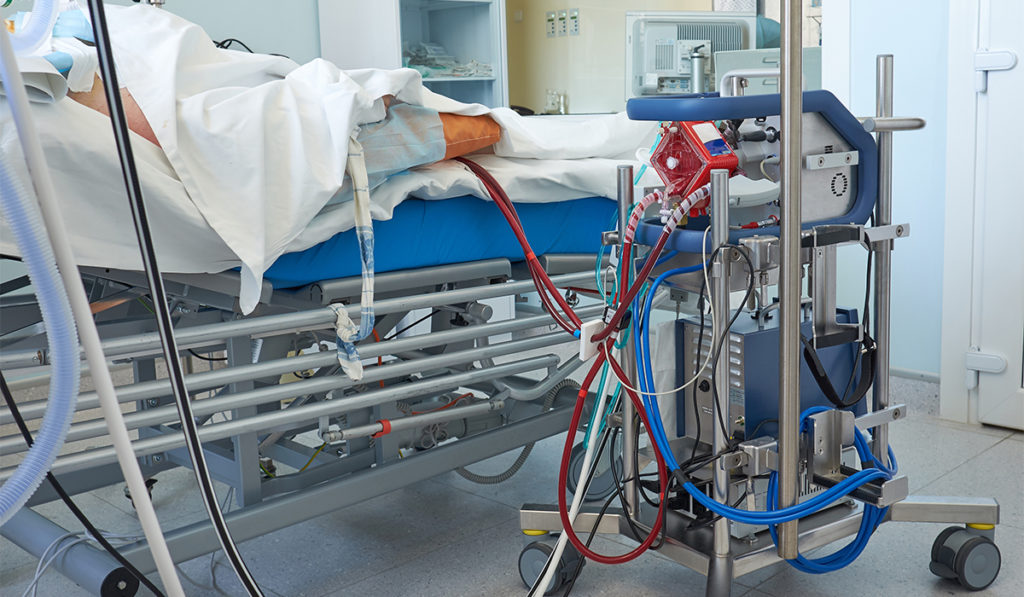Early reports from Wuhan and Italy suggested extracorporeal membrane oxygenation (ECMO) had a disastrous impact on patients with COVID-19. Still, rather than discard a decades-long tool for saving patients with viral pneumonia, top cardiac surgeons, pulmonologists and intensivists began weekly Zoom meetings in early March to share their ECMO experiences with this new brand of virus.
As a result of this collaborative effort, ECMO treatments were modified and have become success stories. French physicians reported high success rates in 200 ECMO cases by mid-April, and multiple institutions in North America began to report better outcomes, said Ashish Shah, M.D., chair of the Department of Cardiac Surgery at Vanderbilt University Medical Center
Shah was among the early participants in the collaboration, which began with a cardiology team in Philadelphia and has since grown to more than 40 experts. “We are on an international call every Friday to examine the ECMO experience in leading centers across the world. It’s really changed people’s minds about ECMO,” Shah said.
“We aren’t waiting for peer-reviewed studies with data reported at a conference. We are simply talking about what is working. It took the fierce urgency of a pandemic to teach us how effective this kind of collaboration can be,” he said.
“It took the fierce urgency of a pandemic to teach us how effective this kind of collaboration can be.”
Collaboration Key to Preparedness
The first lesson from these meetings was the importance of preparedness. While Vanderbilt has needed to use ECMO on only one COVID-19 patient to date, the medical center is ready with patient selection criteria, ECMO methods consistent with what is known about the virus, and measures to keep team members safe. A local consortium of the three major hospitals in the region has informally coordinated care and share a database of local cases.
Internal protocols also addressed the allocation of potentially limited resources. “Because ECMO is so resource-intensive, it is particularly important to be able to predict where it will work, which is another reason why the collaborations are so important. Many centers may be forced to make difficult decisions between one patient’s ECMO care versus the needs (staff, blood products, etc.) of 10 other patients,” Shah said.
Tailoring ECMO for COVID-19
Participants in the Zoom meetings shared techniques, patient selection and timing criteria that coalesced into customized ECMO therapy for COVID-19. The conventional focus on how to safely give oxygen and remove carbon dioxide shifted to how to use ECMO to help mitigate the effects of the virus.
For example, teams that dealt with the pandemic early learned a great deal about how to place and run tubes to mitigate the higher clotting risks that attend the virus.
“We wouldn’t have learned this five years ago without this sort of collaborative effort,” Shah said. “We also learned a lot about timing. There is a window in which a severely ill patient has a chance to get better with conventional therapies, but we need to watch them closely so that if they take a turn for the worse, we can quickly pivot to ECMO.”
COVID-19’s Silver Lining
With pneumonia accounting for 250,000 hospital stays and 50,000 deaths each year in the U.S. alone, the collaboration may have provided a rare silver lining to the pandemic. “The number of patients kept alive through ECMO support is giving physicians the chance to better understand how we can prevent and mitigate these infections before they spiral into a potentially lethal pneumonia,” Shah said.
Specifically, COVID-19 has created a platform for improving the speed of lung recovery and for learning to use ECMO to calm cytokine storms, Shah said. This includes the use of new cytosorbent products that can be attached to the EMCO circuit.
Shah believes that the informal, collaborative methods used during COVID-19 will outlive the current crisis. “The normal tempo was to wait for national meetings to share data. This experience of talking, and making it habitual, has taught us that we can easily share information on a digital level, almost instantly. I foresee continuing to do this in multiple other areas,” he said.
“This experience of talking, and making it habitual, has taught us that we can easily share information on a digital level.”





